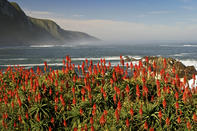Interesting Mix of Species
The Tsitsikamma Coastline is the meeting place of temperate and sub-tropical marine environments, so an interesting mix of species occurs along this wild coastal margin. Massed beds of brown mussels and limpets cling to the wave-pounded shore.

Limpets may number up to 2 500 individuals in a square metre of rocky beach. Bright waving stalks of jelly-like anemones, clusters of spiky sea-urchins, rubbery carpets of zoanthids and colourful, flowery algal fronds infest the more sheltered rock pools. But all is not peaceful in these pools, where whelks and star-fish are aggressive predators of the other creatures.
Nothing here is harmful to man, though - not even the octopuses whose powerful beaks could inflict a painful bite if ever they were used for this purpose. Only by seeing the vibrancy and abundance of this protected coastline can we appreciate the damage done to coasts by modern man, who wantonly collects various organisms for bait and then over-fishes the waters, who strips the rocks for mussels and oysters, and who so casually dumps his domestic and industrial wastes into the sea.
Flowers Overlooking the Sea

The popular Otter Trail winds along the ruggedly beautiful coastline of the park, where Cape clawless otters hunt in the shallows for crabs, though hikers seldom spot them, where dusky dolphins tear through the swells, Cape fur seals dart after fish like torpedoes and loll on the surface to bask, and southern right whales come to calve in the nearby bays.
Observant hikers may identify many of the 35 species of marine birds found here, including black oyster-catchers, sooty shearwaters, Arctic skuas and various terns and gulls. High yellowwood forest occupies deeper valleys, shady slopes and all the higher ground between sea and mountain tops, while low scrub forest grows in more exposed places where the soil is fertile.
On exposed, less fertile slopes, coastal fynbos blazes with erica and mimetes inflorescences, cone bushes, pincushions, sugarbushes and other proteas, interspersed with scarlet Knysna lilies, butter-yellow gazanias and the compact, fiery, orange-red blooms of krants aloes that grow on rocky outcrops overlooking the sea. The nectar from these flowers attracts malachite, orange-breasted and collar sunbirds with their dazzling metallic plumages, while grysbok and grey duiker, three species of mongoose, baboons and dassies (rock hyraxes) inhabit the fynbos and scrub forest.
By David Bristow